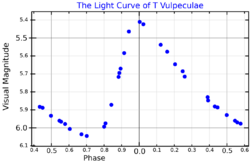Astronomy:T Vulpeculae
| Observation data Equinox J2000.0]] (ICRS) | |
|---|---|
| Constellation | Vulpecula |
| Right ascension | 20h 51m 28.23825s[2] |
| Declination | +28° 15′ 01.8166″[2] |
| Apparent magnitude (V) | 5.754[3] (5.41 – 6.09)[4] |
| Characteristics | |
| Spectral type | F5 Ib + A0.8 V[5] |
| B−V color index | +0.616±0.049[6] |
| Variable type | δ Cep[4] |
| Astrometry | |
| Radial velocity (Rv) | −2.6±0.6[6] km/s |
| Proper motion (μ) | RA: +3.496[2] mas/yr Dec.: −15.087[2] mas/yr |
| Parallax (π) | 1.6738 ± 0.0891[2] mas |
| Distance | 1,900 ± 100 ly (600 ± 30 pc) |
| Absolute magnitude (MV) | −3.19[5] |
| Details | |
| T Vul A | |
| Mass | 4.9[5] M☉ |
| Radius | 35.6±4.4[7] R☉ |
| Luminosity | 1,620[5] L☉ |
| Surface gravity (log g) | 1.75[8] cgs |
| Temperature | 6,220[8] K |
| Metallicity [Fe/H] | 0.01[9] dex |
| Age | 120[9] Myr |
| T Vul B | |
| Mass | 2.1[5] M☉ |
| Other designations | |
| Database references | |
| SIMBAD | data |
T Vulpeculae is a possible binary star system in the northern constellation of Vulpecula, near the star Zeta Cygni, close to the pair 31 Vulpeculae and 32 Vulpeculae.[11] It is visible to the naked eye with an apparent visual magnitude that ranges around 5.75.[3] The distance to this system is around 1,900 light years, as determined from its annual parallax shift of 1.67 mas.[2]
A well-studied Classical Cepheid variable and one of the brightest known,[12] the apparent magnitude of T Vulpeculae ranges from 5.41 to 6.09[4] over a period of 4.435 days.[3] It is a yellow-white hued supergiant of spectral type F5 Ib.[5] The variability of T Vul was discovered in 1885 by Edwin Sawyer.[13] Observations between 1885 and 2003 shows a small but continuous decrease in the period of variability amounting to 0.25 seconds per year.[14]
The companion star was detected in 1992;[12] it is an A-type main-sequence star with a class of A0.8 V and 2.1 times the Sun's mass.[5] Orbital periods of 738 and 1,745 days have been proposed for the pair, although, as of 2015, there remains doubt as to whether this is an actual binary system.[15]
References
- ↑ Kiss, Laszlo L. (July 1998). "A photometric and spectroscopic study of the brightest northern Cepheids - I. Observations". Monthly Notices of the Royal Astronomical Society 297 (3): 825. doi:10.1046/j.1365-8711.1998.01559.x. Bibcode: 1998MNRAS.297..825K.
- ↑ 2.0 2.1 2.2 2.3 2.4 2.5 Brown, A. G. A. (August 2018). "Gaia Data Release 2: Summary of the contents and survey properties". Astronomy & Astrophysics 616: A1. doi:10.1051/0004-6361/201833051. Bibcode: 2018A&A...616A...1G.
- ↑ 3.0 3.1 3.2 Evans, Nancy Remage et al. (July 2015). "Binary Properties from Cepheid Radial Velocities (CRaV)". The Astronomical Journal 150 (1): 18. doi:10.1088/0004-6256/150/1/13. 13. Bibcode: 2015AJ....150...13E.
- ↑ 4.0 4.1 4.2 BSJ (4 January 2010). "T Vulpeculae". AAVSO Website. American Association of Variable Star Observers. http://www.aavso.org/vsx/index.php?view=detail.top&oid=38178. Retrieved 24 January 2014.
- ↑ 5.0 5.1 5.2 5.3 5.4 5.5 5.6 Evans, Nancy Remage; Bond, Howard E.; Schaefer, Gail H.; Mason, Brian D. et al. (2013). "Binary Cepheids: Separations and Mass Ratios in 5M ⊙ Binaries". Astronomical Journal 146 (4): 93, 10. doi:10.1088/0004-6256/146/4/93. Bibcode: 2013AJ....146...93E.
- ↑ 6.0 6.1 Anderson, E.; Francis, Ch. (2012), "XHIP: An extended hipparcos compilation", Astronomy Letters 38 (5): 331, doi:10.1134/S1063773712050015, Bibcode: 2012AstL...38..331A.
- ↑ Gallenne, A. et al. (May 2012). "Mean angular diameters, distances, and pulsation modes of the classical Cepheids FF Aquilae and T Vulpeculae. CHARA/FLUOR near-infrared interferometric observations". Astronomy & Astrophysics 541: 5. doi:10.1051/0004-6361/201219102. A87. Bibcode: 2012A&A...541A..87G.
- ↑ 8.0 8.1 Gray, R. O. et al. (2001). "The Physical Basis of Luminosity Classification in the Late A-, F-, and Early G-Type Stars. II. Basic Parameters of Program Stars and the Role of Microturbulence". The Astronomical Journal 121 (4): 2159. doi:10.1086/319957. Bibcode: 2001AJ....121.2159G.
- ↑ 9.0 9.1 Marsakov, V. A.; Koval', V. V.; Kovtyukh, V. V.; Mishenina, T. V. (2013). "Properties of the population of classical Cepheids in the Galaxy". Astronomy Letters 39 (12): 851. doi:10.1134/S1063773713120050. Bibcode: 2013AstL...39..851M.
- ↑ "HD 198726". SIMBAD. Centre de données astronomiques de Strasbourg. http://simbad.u-strasbg.fr/simbad/sim-basic?Ident=HD+198726.
- ↑ Moore, Patrick (2000), Exploring the Night Sky with Binoculars, Cambridge University Press, p. 147, ISBN 978-0521793902, https://books.google.com/books?id=Jvbtl2Vyxm4C&pg=PA147
- ↑ 12.0 12.1 Evans, Nancy R. (July 1992). "The luminosity of the classical Cepheid T VUL". Astronomical Journal 104 (1): 216–219. doi:10.1086/116232. Bibcode: 1992AJ....104..216E.
- ↑ Sawyer, E. F. (1886). "On a new variable star in the Constellation Vulpecula". Astronomische Nachrichten 113 (16): 265. doi:10.1002/asna.18861131608. Bibcode: 1886AN....113..265S. https://zenodo.org/record/1424725.
- ↑ Meyer, Ralf (August 2006). "T Vulpeculae: Maximum Times Covering 120 Years Show a Slight, Continuous Period Decrease". Open European Journal on Variable Stars 46: 1. Bibcode: 2006OEJV...46....1M.
- ↑ Gallenne, A. et al. (July 2015). "Robust high-contrast companion detection from interferometric observations. The CANDID algorithm and an application to six binary Cepheids". Astronomy & Astrophysics 579: 12. doi:10.1051/0004-6361/201525917. A68. Bibcode: 2015A&A...579A..68G.
 |


